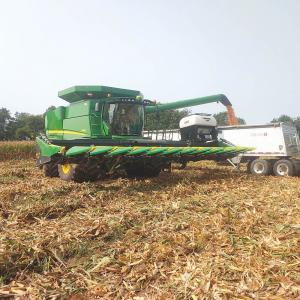2024 - Volume #48, Issue #3, Page #24
[ Sample Stories From This Issue | List of All Stories In This Issue | Print this story
| Read this issue]
Combine-Mounted Cover Crop Seeder
 |
Even then, McCormick was no stranger to dual-purpose field trips. More than 30 years ago, he mounted a home-built adjustable height spray boom on the back of his no-till drill (Vol. 17, No. 1). He saved a pass, applying burndown while he planted. The same principle holds true with his cover crop seeding. It involves air seeders mounted on his headers. It saves money and time versus seeding with a drill.
When FARM SHOW first interviewed McCormick, he had one season under his belt with a Gandy air seeder on his (then) 8-row corn head. He had planned on using a Valmar unit at the time, but none were available when he needed one.
“I called Valmar, and they said it would be 6 mos.,” he recalls. “I called Gandy, and they said 6 weeks. I told them I needed one in 6 hrs. They said they had one torn apart and sent it to us. We put it together and did 300 acres with it.”
He tied electrical and hydraulic connections into excess ports on the quick connect so it disconnected with the header. He ran the air hoses behind the header and under the snapping rollers.
McCormick wanted to compare how the combine mounted Gandy compared to the no-till drill, find problems, and fix them before the next season. There were no problems, and the drill was retired from cover crops. The only change was to mount deflector plates in front of the hoses, so the seed spread out more evenly.
The plates ensured the seed hit the ground ahead of residue coming through the corn head. The seed gets soil contact, and the residue provides a protective mulch for the seed. McCormick liked the even spread and emergence of the broadcast seed versus the rows on 7 1/2-in. centers.
“It looked like a seeded lawn. It spread so accurately,” he says.
To get the most acres out of the Gandy’s small hopper, McCormick switched his cover crop mix to small, annual ryegrass and clover seed. When the company sent him a prototype low-profile unit, McCormick mounted it on his Deere bean head. However, when he later went to a MacDon draper header, he outfitted it with a Valmar air seeder instead of the Gandy.
“The Valmar hopper is about four times that of the Gandy,” says McCormick. “The Gandy unit is ground driven. The Valmar is hydraulically driven, which gives it better control, and I can adjust it on the go. I can slow down on erodible ground and seed at a heavier rate.”
Initially, he mounted the Valmar on the side of the draper, but the weight interfered with the spring-mounted MacDon. He then moved it to dead center with a bracket that scissored up and down when the draper raised and lowered with the contour of the ground.
A few years later, he switched to a Deere draper header and moved the Valmar to its current position on an also upgraded, 12-row corn head. The downside to that move was that when mounted to the side of the corn head, a filled hopper was too much weight. However, even half filled, it carries enough seed that filling it before starting up in the morning and again at noon is usually sufficient.
Mounting two Gandy’s on the new Deere draper header made it equally efficient at spreading cover crop seed. Combined, they’re equal to the half-hopper Valmar. McCormick has them plumbed to spread seed from one, and when it is empty, switch to the other.
Mounting air seeders on his combines has been a success for McCormick. They have helped turn annual Ohio River flooding from a negative to a positive.
“I pick our corn high, leaving stubble standing high with cover crop anchoring the residue and the soil,” he says. “Not only do we not lose soil, but I’m also catching about 30 tons of topsoil per acre with each flood.”
His only problem was when he forgot to turn on the air seeder for 35 ft. The next spring, the value of air-seeded cover crop was apparent.
“Where there was no cover crop, the flood scoured away about 7 in. of soil,” he says. “Where the cover crop and high stubble were, I picked up 7 in.”
Contact: FARM SHOW Followup, Ray McCormick, 6751 S. McCormick Rd., Vincennes, Ind. 47591 (ph 812-881-7321; mccfarms@gmail.com).

Click here to download page story appeared in.

Click here to read entire issue
To read the rest of this story, download this issue below or click here to register with your account number.




